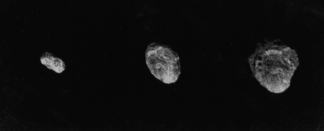Blazing Hyperion on his orbed fire


Still sits, still snuffs the incense teeming up
From man to the Sun’s God: yet unsecure.
—John Keats (1795–1821), Hyperion
When the Saturn-orbiting Cassini spacecraft swung within 500 kilometers of Saturn’s moon Hyperion last month, it snapped close-up photos that revealed a spectacularly cratered, craggy, splintered pile of rubble. With its spongy look, it bore little resemblance to any other satellite of Saturn.
Hyperion’s strangeness wasn’t evident when the satellite was first identified in 1848. It appeared to be a small, unremarkable satellite, less than a tenth the size of Earth’s moon. It orbited Saturn once every 21.28 days, staying an average of 1,480,000 kilometers away from the planet.
When the Voyager 2 spacecraft swept past Saturn in 1981, its photos revealed the satellite to be an extended blob instead of a sphere. Scientists monitoring the encounter initially compared Hyperion’s shape to a hamburger, but subsequent views of different sides kept them revising the comparison, from a fat, oval hamburger to a deformed, battered football to a potato or a peanut.
Careful analysis of the images later revealed this oddly shaped, pock-marked satellite to be nearly twice as long as it is wide, measuring about 380 by 290 by 230 kilometers. It was, indeed, the most irregularly shaped of the major satellites.
Stranger still, however, was its orientation. Such an elongated satellite, with its long axis pointed toward Saturn’s equator, ought to be spinning about its short axis. The Voyager images hinted that Hyperion might instead be tilted and its spin axis skewed.
Whatever the orientation of its spin axis, Hyperion also seemed to be spinning once every 13 days while orbiting Saturn. That, too, was unusual. The moon, for example, completes one rotation in the time that it takes to go once around Earth, thus always presenting the same face to an Earth-based observer. Indeed, all major satellites except Hyperion exhibit 1:1 resonances between their orbital and rotational periods.
Why hadn’t Hyperion settled down, locking one face toward Saturn?
In 1984, Jack Wisdom, Stanton Peale, and François Mignard identified two key factors that prevent Hyperion from going into a synchronous state: its unusual, elongated shape and the influence of Titan, its giant satellite neighbor. These varied influences add up to a persistently precarious balance of forces.
The trio boldly predicted that, unlike all other major natural satellites in the solar system, Hyperion tumbles in its orbit instead of spinning smoothly like a top. The satellite’s spin period should vary and the orientation and position of its spin axis should shift in only a few orbital periods.
Wisdom estimated that Hyperion’s spin rate could go from no rotation at all to one rotation every 10 days in as few as two trips around Saturn.
Supported by computer simulations, the scenario developed by Wisdom, Peale, and Mignard strongly indicated that Hyperion displays a curious amalgam of the orderly and the chaotic. Because it follows a regular, predictable orbit, astronomers can calculate its position years ahead and be off by no more than a fraction of a second. At the same time, the direction in which the satellite’s spin axis points—its attitude—is considerably less predictable.
Through careful observations of the satellite’s varying brightness, as seen from Earth-based telescopes, James Klavetter was subsequently able to provide evidence that the satellite actually does tumble.
Interestingly, the Voyager and Cassini images of Hyperion’s battered surface supply circumstantial evidence supporting the notion that the satellite’s spin is chaotic. Hyperion may very well have started out as a more-or-less spherical body. Like other satellites of Saturn, it was probably heavily bombarded by primordial orbital debris.
However, while other satellites may have fragmented and reassembled several times over many millions of years, Hyperion’s chaotic motion may have prevented that from happening. Instead of falling back onto the parent body, fragments ejected from crash landings on Hyperion remained adrift. What we now call Hyperion may be merely the biggest chunk left over from a massive catastrophic impact that left the satellite a scarred, craggy shadow of its former self.
At the same time, it’s highly unlikely that Hyperion started out in a chaotic state. In the distant past, Hyperion’s rotational period, or day, was much faster than its orbital period, or year. As tidal forces over eons gradually slowed the satellite’s rotation, Hyperion would inevitably have reached rotational velocities that sent it into a chaotic zone. At this critical stage, its spin axis was probably nearly perpendicular to its orbital plane.
Once the satellite entered the chaotic zone, however, this hard-won attitude stability was undone in a matter of days, and Hyperion started to tumble.
Hyperion now seems trapped in this type of motion. Because the chaotic zone surrounding the 4:3 resonance between the orbital periods of Hyperion and Titan is so vast, the chance that the satellite’s orbit will ever reach one of the few small islands of stability in the vicinity appears minimal.
Already enshrined in textbooks, the Hyperion example stands as the first conclusive demonstration of chaotic motion in the solar system.






